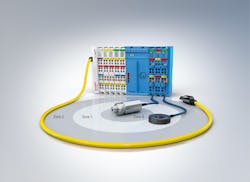Automation World Exclusive Interview with Beckhoff
2020 was a year of change for everyone, and the industrial automation sector did not escape unscathed. After several years of growth and expansion, many industrial technology suppliers experienced significant downward impacts on sales and revenues. Even those suppliers that managed to have a year with positive earnings still felt the pinch compared to the levels of growth the industry had seen for years prior to the pandemic.
Automation World recently had the opportunity to speak with Hans Beckhoff, managing director and founder of Beckhoff Automation, and Kevin Barker, president of Beckhoff USA. The idea behind this interview was to get insights into Beckhoff’s experience as a global supplier of industrial automation technologies during a year that so dramatically changed personal and business perspectives and to get insights into what may lie ahead for the automation industry.
What 2020 wrought
Our discussion began with a review of a Beckhoff’s business in 2020. Hans Beckhoff noted that his company had been experiencing an average growth rate of 14% since 2000. However, in 2020, that rate of growth shrank to about 2%, buoyed by a strong performance from Beckhoff China, which grew by 20% in 2020, as well as a good performance in the U.S., where the business grew by 5%. For 2021, Beckhoff sees positive business development worldwide based on its current double-digit growth rate. The company reportedly generates more than $1 billion in revenue worldwide.
Barker noted that Beckhoff’s “highly diversified” portfolio of products and industries it serves contributed to the company’s good performance in 2020.
“We don't have more than 15% of our business in any one particular vertical,” said Barker, “so when some of our existing customers did not invest in new theme parks or new oil and gas exploration, we still saw new projects with electric vehicles, semiconductor manufacturing, intralogistics, and packaging.”
He added that Beckhoff’s technology portfolio, including TwinCAT control software, industrial PCs, I/O, drives and motors, contribute to the company’s ability to address a wide range of specific projects.
“In the U.S., it's pretty evenly distributed and that’s because we are working with innovative companies looking to solve really important problems. And that starts at the control architecture and extends to the entire approach to automation. So, when we have these engagements, we see the revenue streams across all our different product families. We are leading the way with emerging technologies—like mechatronics—which have been a growth engine for us. But we see strong growth across all of our different product families.”
Hans Beckhoff added that the Beckhoff automation architecture is “quite unified across I/O, bus terminals, CPUs, motors and drives, and software, which can be used to do very small applications like controlling a conveyor or very complex and big applications like machine building or logistical transportation projects. Regardless of the application, it's always the same hardware with basically the same TwinCAT software.”
One differentiator that Beckhoff pointed to is that his company’s automation architecture is software-based and supported by modular hardware. “There are, of course, some differences in the software algorithms for different applications,” Beckhoff explained, “but control can be realized with this unified hardware, which helps us with a lot of different customers in different segments.”
At the IT/OT crossroads
As a supplier and proponent of PC-based control, Beckhoff has long positioned itself at the crossroads of IT and OT (operations technology)—an area that has gained increasing attention as the drive toward Industry 4.0 and Industrial Internet of Things applications brings these two technology worlds closer together.
He contends that Beckhoff’s focus on industrial PCs, I/O communication technology, and its TwinCAT software provide a strong base for delivering edge intelligence, an aspect of Beckhoff’s business that has been growing rapidly as system integrators develop their own edge systems with Beckhoff hardware and “some big machine builders use our hardware to implement their own edge software concepts in different controllers on the machine.”
Beckhoff pointed to a particular feature of the company’s controllers as helping position the company well with integrators and OEMs when it comes to edge computing—the TwinCAT Analytics Logger inside the controller.
“This Analytics Logger works like a flight recorder, in that all signals from the machine are written in real time to a file or can be sent to the cloud. The complete operation of the machine is recorded,” said Beckhoff. “This allows you to do analytics and optimize the machine because you can see how the machine is working from your desk at home. So, if a machine is going down every two weeks in the middle of the night, you can see exactly what is going on. We also have the Analytics Workbench, which incorporates analytics tools like min/max comparisons, fast Fourier transforms, and it even has an interface with MatLab/Simulink for high-end analytics, all of which can be done via standard IEC 61131-3 languages. This means a controls engineer who programs the machine is also able to program the analytics.”
Virtualization
With all the interest in the virtualization of automation technology over the past few years, Beckhoff, as a supplier of PC-based control, is well-positioned to take advantage of this trend. Virtualization has been a mainstay of the IT world for years as a means of dividing physical servers into multiple, virtual servers to run separate operating systems. In the industrial realm, this technology can be used to create virtual machines for control operations.
Our discussion on this point revealed that a good bit of upside remains to be captured around virtualization in manufacturing considering that industry, as a whole, has not been quick to widely adopt virtualization yet.
“Virtualization means very different things to different companies and to different people within those companies in different groups,” said Barker. “Conversations we’re having with OT groups about this now tend to focus on what they’re trying to accomplish with virtualization and what opportunities exist. This is especially true with companies that want to do something specific now, but also have an idea about where they want to go with that in the future. Our platform allows them an easy path to start with something they can get their arms around that has a clear return on investment and is both manageable and secure. Then, when they’re ready, they can use this same platform and toolkit to expand.”
Material handling
Beyond Beckhoff’s focus on automation and control technologies, such as controllers, I/O, standard motion technology and software, the company also offers complete systems for material handling that can be used by OEMs and end users. Two high-profile examples of this are the company’s eXtended Transport System (XTS) and XPlanar. Both systems are relatively futuristic in their design and operation—for example, XPlanar uses levitating tiles to move materials in any direction.
Because of the advanced nature of these systems, we were curious to learn how receptive industry has been of these new material handling technologies.
Beckhoff noted that Plasmatreat was “one of the first XPlanar users in what was a smaller application of the technology. But we’re getting orders for bigger applications too, in some cases due to its ability to hygienically handle materials. For example, a German schnitzel producer is using XPlanar to package their product because of its flexible packing applications. We’re also seeing a lot of interest from biotech for applications like blood analysis, as well as interest in its use for general manufacturing assemblies.”
Barker said some machine builders have had a difficult time envisioning how to use XTS within the type of applications they typically implement. XPlanar, however, “is so different that I think people look at it and can immediately see that it’s a very different approach to manufacturing; but they can also easily envision how it can be used. If you think about it, there hasn't been a lot of significant changes to mass production since Henry Ford. I think XPlanar is potentially one of those fundamental shifts, as we move from a linear to a non-linear approach to material handling at a time when mass customization is everything.”
This ease of setup has led Beckhoff to receive numerous new requests for the starter kits. “We're shipping a starter kit a week right now,” Barker said, “and we also got two orders for new production systems where the users began with the starter kit just two months ago and they've already moved to a completed design and are moving to volume production with XPlanar.”
About the Author
David Greenfield, editor in chief
Editor in Chief

Leaders relevant to this article:



